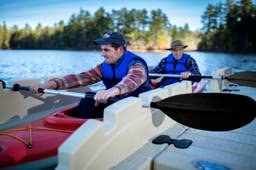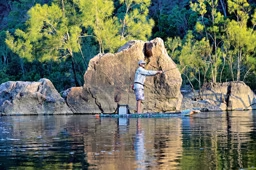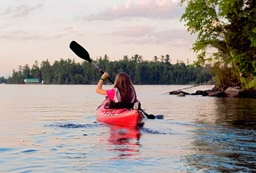
Work of Art
The hot new canoes are high-end special edition models – like the Northwind by Bell Canoe Works (shown). Made of BlackGold carbon fiber, it’s incredibly strong and classically beautiful. Store it on the dock as a sculpture, or just paddle it around to make the neighbors jealous.
See also Your Spring Boat Check List
Accessorizing
If you’re not interested in upgrading to a canoe with more bells and whistles, accessories can totally change your experience on the water. As with kayakers, canoeists want comfort and the ability to customize their boat for how they spend time paddling. There are a slew of outfitting options. Check out supportive seats like the Mad River Canoe’s Comfort Seating System for rotomolded canoes and sport-specific upgrades like rod holders and tackle boxes for canoeing anglers.
See also Lessons in Stand-Up Paddleboarding
Green and More Green
On the green front, dry bags – roll-top bags that seal out water to keep contents, even electronics, dry – are now mostly free of polyvinyl chloride, or PVC.If keeping your paddling environmentally friendly is important to you, make sure your personal flotation device (PFD) is also PVC-free.
Why all the fuss about PVC? As PFD manufacturer Astral Buoyancy states on its Web site, “It is well documented and accepted that the creation of PVC contributes to significant environmental (including human) degradation.” Dioxin, a by-product of PVC manufacture, leaches into water, bio-accumulates in the foodchain, and disrupts human immune system function and hormones and causes cancer.* Most paddlesports companies are in the process of making their gear PVC-free.
Beyond PVC, there are recycled kayaks. In spring 2008, the first 100-percent recycled kayaks will hit stores and then hit the water. Made from repurposed factory scrap, the kayaks have been getting a thumbsup for performance and are hitting the water stiffer and more responsive than some of their non-recycled cousins. 100-percent recycled canoes won’t be far behind.
See also What You Need to Know About PFDs
* Vinyl chloride is classified as a human carcinogen by the U.S. Department of Health and Human Services. And vinyl chloride is classified as one of the 20 most hazardous substances to humans by the U.S. Environmental Protection Agency (according to the Comprehensive Environmental Response, Compensation, and Liability Act Priority List of Hazardous Substances for 2005).










